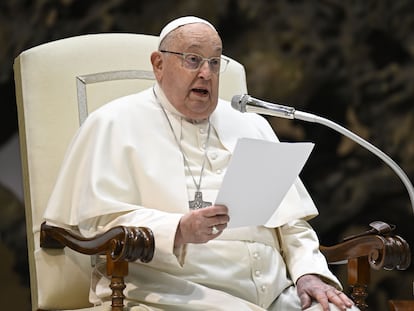The Vatican heads toward a conclave with 15 papal candidates already emerging
The Catholic Church fears the impact of disinformation campaigns on an election that will feature the largest number of cardinals in its history
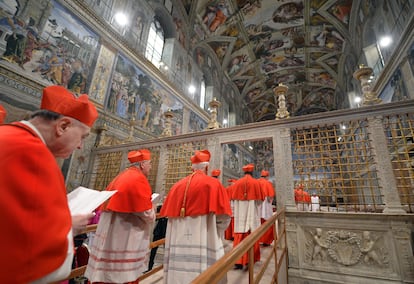
With the death of Pope Francis, people in Rome are already beginning to think about his successor. These are frenetic and uncertain days in the Vatican — a time of mixed grief and the urgency of thinking about the future, all set against an extraordinarily complex global backdrop and within a deeply divided Church. The first congregation of cardinals — the assembly that convenes after the death of the Pontiff — will take place this Tuesday with those already in Rome. This marks the beginning of both formal and informal discussions among them as they search for a new Pope.
Early lists of potential papal candidates are already circulating, both within Vatican circles and in the Italian and international media. These lists are part of the maneuvers underway to promote certain names. These are usually confusing days, where rumors abound, but what stands out so far is that the Italian press has remained notably silent on the subject — something that was commonplace during the final years of John Paul II. This silence reflects the deep uncertainty about the direction the Church may now take in what will be a conclave more numerous and international than ever before: 135 cardinals from 71 countries, compared to 115 electors in 2005 and 2013 from 52 and 48 countries, respectively. In other words, the Sistine Chapel will be filled with unfamiliar faces, both outside the doors and within, and some of them do not even speak Italian.
Strong internal division makes the situation even more challenging. As has always been the case, a reformist faction of the Church, more aligned with Pope Francis, seeks to continue his path, while a more conservative faction, which has fiercely opposed his decisions in recent years, aims for a retreat. Given the intensity of this clash in recent years, there is now a real concern within the Holy See about something that did not exist in previous conclaves — at least not on this scale: disinformation campaigns and fake news designed to influence the election of the Pope, with hoaxes spreading on social media, aiming to discredit candidates who are undesirable to certain sectors. This will be something to watch in the coming days.
The task of shifting votes and organizing the conclave typically falls to the so-called “great electors” — cardinals who do not expect to be elected themselves but who gather support and are respected figures who can steer the trends. On the conservative side, there are figures such as Timothy Dolan, Archbishop of New York, and the former Prefect of the Doctrine of the Faith, Gerhard Ludwig Müller.
On the more progressive side, there are influential cardinals close to Pope Francis, such as Jean-Claude Hollerich of Luxembourg, the general rapporteur of the Synod. However, at 66, Hollerich is considered too young, as it would likely result in a pontificate that could last for many years. Another prominent figure is the Canadian Michael Czerny, Prefect of the Dicastery for Promoting Integral Human Development, who is a Jesuit. However, it seems unlikely that the Church will choose another pope from this order.
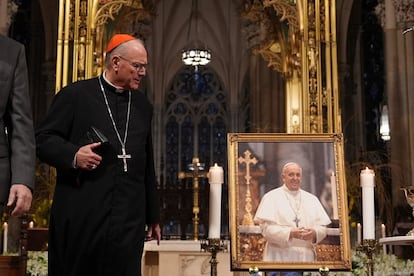
The key factor to remember is that 90 votes — two-thirds of the 135 cardinals entering the conclave — are required to elect the new pope. A faction with some support isn’t enough; it must be a truly consensual decision. Many who disagree must be convinced of a shared vision, where strength and personal magnetism also play a role. However, unlike previous conclaves, there are no clear frontrunners, and this one is expected to be more laborious and prolonged.
In 2005, with four votes, and in 2013, with five, the process lasted only 24 hours. This time, it could resemble the conclave of October 1978, which took eight votes and resulted in the election of an unknown, John Paul II. It is likely that surprises will emerge once again. Pope Francis has certainly structured this conclave to encourage such outcomes. He has appointed 79% of the cardinals, often selecting lesser-known figures — profiles that reflect the Church he has sought to shape: one that is closer to the people and the margins of society.
At present, it is possible to draw up a list of at least 15 potential papal candidates. To begin with, despite this being a conclave that is no longer Eurocentric, the belief that the pope must come from Italy still persists, as it has for centuries, though much of the Church finds it impossible to return to that tradition. Italy boasts the largest group of cardinals, 17 in total, and this carries weight.
Three Italian cardinals are currently being mentioned as possible contenders. One of them is Pietro Parolin, 70, the current Secretary of State. This position is typically associated with papal candidates due to the experience it offers in governance and as a symbol of continuity — if that is the goal, rather than a change. However, despite his experience, Parolin has little pastoral experience and has alienated some sectors due to the balancing act he has had to navigate in recent years.
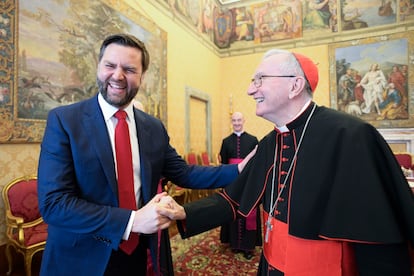
The second Italian in the running is Matteo Zuppi, 69, Archbishop of Bologna and president of the Italian bishops’ conference. He is aligned with Pope Francis and is a member of the Sant’Egidio community, known for its work in international conflict mediation and its strong social vocation. Another contender is the Patriarch of the Holy Land, the Franciscan Pierbattista Pizzaballa. Well-known in the media for his role in the Middle East, Pizzaballa is highly regarded, but he faces a disadvantage due to his age — 59 — at a time when a transitional solution might be preferred.
Another name that has frequently emerged in recent years — he was a papal candidate in 2013 — is 67-year-old Filipino Luis Antonio Gokim Tagle, whose mother is Chinese. He would be the first Asian pope, a possible option if Francis, the first pontiff from the Americas, is to be followed by a pope from outside the Western hemisphere. However, his popularity has waned due to his controversial management of the charity organization Caritas International.
In Asia, two other names often come up. The first is Charles Bo, Archbishop of Yangon in Myanmar. Bo is distinguished for his defense of human rights in a country under military rule and has presided over the Federation of Asian Episcopal Conferences for the past six years.
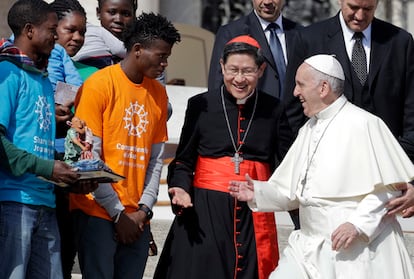
The second potential candidate is Malcolm Ranjith from Sri Lanka, Archbishop of Colombo, who previously served as secretary of the Congregation for Divine Worship. At 77, Ranjith brings a wealth of experience, making him a candidate for a short papacy — potentially serving as a temporary counterbalance to Pope Francis. He is considered part of the more traditionalist camp, which could hinder consensus.
The same applies to another frequently mentioned name, Robert Sarah of Guinea, who has openly clashed with Pope Francis in recent years, positioning himself further on the conservative side.
The most frequently discussed African candidate is Fridolin Ambongo Besungu, Archbishop of Kinshasa in the Democratic Republic of the Congo. A Franciscan, Ambongo is well-regarded by conservatives and has led the opposition to the blessing of same-sex unions.
After Pope Francis became the first pontiff from the Americas, there have not been many standout names in the continent. However, one candidate who straddles both halves of the continent is Robert Francis Prevost, 69, Prefect of the Congregation for Bishops. He is American but has spent nearly his entire life in Peru. His candidacy would send a strong signal in facing the complex challenges of the Donald Trump era, particularly as the U.S. Church is at odds with him. The ultraconservative movement in the United States is eager to politically co-opt the Christian message, framing it as a crusade between good and evil.
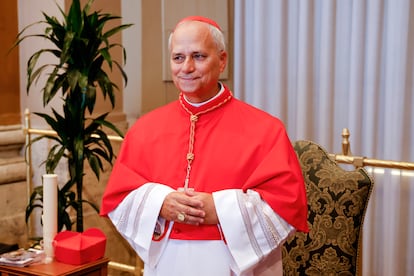
Following the election of Pope Francis, the first non-European pope since Gregory III (who was born in Syria in the 8th century), leaving Europe now appears to be a clear direction. However, there are still candidates from the Old Continent. The most unusual among them is Anders Arborelius, 75, Bishop of Stockholm. A Carmelite who was raised Lutheran and later converted to Catholicism, he combines social openness with pastoral rigor. Another potential candidate is Peter Erdo, 72, Archbishop of Budapest. Born under Communism, he is a cultured man and a leading figure in the conservative camp in recent years.
Also in the running is Jean-Marc Aveline, 66, Archbishop of Marseille. A seasoned bishop with a strong presence among the socially underprivileged, a group emphasized by Pope Francis, Aveline is an expert in interreligious dialogue. However, his age suggests that he could serve a lengthy papacy.
On the conservative side, one respected figure is Willem Jacobus Eijk, 71, Archbishop of Utrecht, who remains faithful to the line of Benedict XVI. Another candidate is José Tolentino de Mendonça, a 66-year-old Portuguese cardinal. Prefect of the Dicastery for Culture and Education, a poet and theologian, he has been steadily rising within the Curia and is known for his intellectual approach, his attention to the poor, and his connection to Africa — having spent his childhood in Angola. Finally, Mario Grech, 68, from Malta, has served as Pope Francis’s right-hand man in the synodal process as Secretary General.
Sign up for our weekly newsletter to get more English-language news coverage from EL PAÍS USA Edition
Tu suscripción se está usando en otro dispositivo
¿Quieres añadir otro usuario a tu suscripción?
Si continúas leyendo en este dispositivo, no se podrá leer en el otro.
FlechaTu suscripción se está usando en otro dispositivo y solo puedes acceder a EL PAÍS desde un dispositivo a la vez.
Si quieres compartir tu cuenta, cambia tu suscripción a la modalidad Premium, así podrás añadir otro usuario. Cada uno accederá con su propia cuenta de email, lo que os permitirá personalizar vuestra experiencia en EL PAÍS.
¿Tienes una suscripción de empresa? Accede aquí para contratar más cuentas.
En el caso de no saber quién está usando tu cuenta, te recomendamos cambiar tu contraseña aquí.
Si decides continuar compartiendo tu cuenta, este mensaje se mostrará en tu dispositivo y en el de la otra persona que está usando tu cuenta de forma indefinida, afectando a tu experiencia de lectura. Puedes consultar aquí los términos y condiciones de la suscripción digital.
More information
Archived In
Últimas noticias
Chris Martin, Taylor Swift, Elijah Wood and other famous wedding ‘crashers’
‘How does it feel to be a failure?’: Elizabeth Berkley’s journey from ‘Showgirls’ ridicule to vindication
The story of the Málaga virus: The code that haunted Google’s cybersecurity center director for 30 years
The impact of Ecuador’s mega-prison: A polluted river, cleared forests and military checkpoints
Most viewed
- Christian Louboutin: ‘Young people don’t want to be like their parents. And if their parents wear sneakers, they’re going to look for something else’
- The low-cost creative revolution: How technology is making art accessible to everyone
- Liset Menéndez de la Prida, neuroscientist: ‘It’s not normal to constantly seek pleasure; it’s important to be bored, to be calm’
- All the effects of gentrification in one corner of Mexico’s Colonia Roma
- December Social Security and SSI payments: Dates, double checks and the 2026 COLA increase


